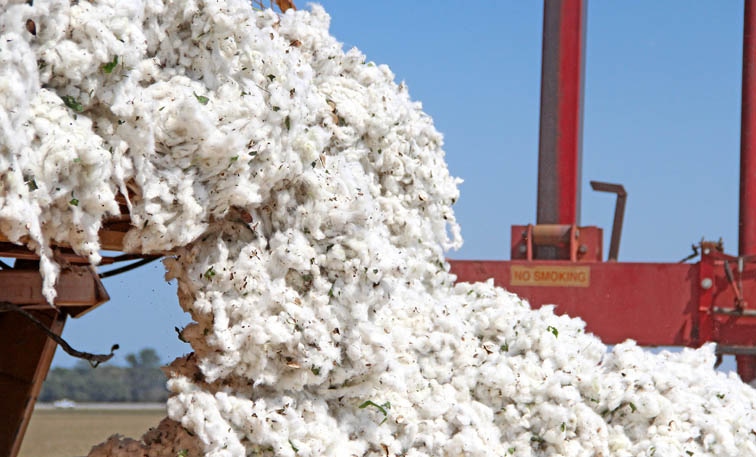
Cotton spinners are chasing cotton between a tight trading range of 82 cents to 88 cents, according to cotton analyst O.A. Cleveland, speaking at the Ag Market Network’s May conference call.
Cleveland noted that recent rallies in physical and futures prices for cotton “ran into very stiff resistance as the Asian price for cotton got up to about 95 cents at the Liverpool index,” said Cleveland, professor emeritus at Mississippi State University. “The same resistance halted the rally on Intercontinental Exchange futures near 88 cents in both old and new crop futures.”
Cleveland said spinners were concerned about whether they could move yarn with cotton at that price “and they stepped out of the market.”
Prices fell to around 82 cents to 84 cents before spinners got back into the market and have since to move back up. While spinners are in no mood to chase cotton prices higher, Cleveland noted their scant coverage for down the road. “They’re getting in to a little bit of a squeeze.”
“The fall below 88 cents on May 10 left the market in a much weaker situation after a second attempt to move higher,” Cleveland said. “In one way, this confirmed our expectations that we would have a considerable problem with 90 cent cotton. We’ve been talking for some time now that cotton above 90 cents is a point at which you begin to lose your market.”
According to textileworld.com, 30-count, ring-spun, 100-percent carded cotton is up 9 cents a pound from a year ago, from $2 to $2.09, while 30-count, 50/50, polyester/carded cotton is up a penny from a year ago, from $2.27 to $2.28 a pound.
The decline in cotton prices also coincided with USDA May supply and demand report in which USDA pegged the 2013-14 world cotton crop at 117.8 million bales and projected that China will import around 12 million bales, down 6 million from the year before. U.S. exports are estimated at 11.5 million bales. World ending stocks were estimated at 93 million bales, the third consecutive seasonal record.
Texas A&M Extension economist John Robinson believes China keeping cotton stocks off the market through its reserve program has put more risk in the market.
“We’re stuck in this recording of China having a policy that is constraining the world supply of available stocks, therefore holding the price up. That will continue until they stop doing that. All indications are that they are going to keep doing what they’re doing.
“But it’s in the hands of bureaucrats. That’s the point. To me that still imposes a really big downside risk on this whole scenario.”
Carl Anderson, Extension professor emeritus at Texas A&M, says China’s policy puts producers outside China in a dangerous financial situation. “So set a price floor the best you can in this market.”
Anderson fears China could decide “to slow down, quit buying imports or release the supply of the surplus, which is just tremendous. This could send the market tumbling downward. I would think 60 cents is not out of the picture if that scenario were to develop. I don’t know how many times in my career that China has suddenly made an about-face that none of us were really anticipating. It just tears the situation up, and then they buy cheap cotton for another three years or so.”
Anderson noted that China holds about 63 percent of the world stocks, and rest of the world holds just 37 percent. “If they hold that position, then the rest of the world is going to have tight stocks, and we’re going to hold the market at least where we are now and maybe go up a little bit.”
Ag news delivered daily to your inbox: Subscribe to Delta Farm Press Daily.
Cleveland says cotton prices have the potential to move higher based on the long-term drought in West Texas. “We could certainly move back into the 90s, but I have to say that 88 cent barrier is a little stiffer than it had been. I also believe 82 cents is stronger as downside support. We’ve had tremendous sales any time we get down below 84 cents.”
With the rally toward 90 cents somewhat in check, Cleveland noted, “My bullish toes have been stepped on a bit, but not so much. We still have mills that are not covered into the third or fourth quarter. So a lot of cotton is going to have to be bought, and mills would be content if it stayed around 86 cents to 87 cents.”
Kelli Merritt, cotton farmer, broker and merchant from Lamesa, Texas, says large spec funds were also part of the pullback. “They did take profits at the top, and that put a heavier lid on the market. But they came back later in the week with long positions. That may not put us back into the mid-90s, but it’s giving strength to support down at 82 cents.”
You might also read:
5 major trends pose threat to American farming
9 factors that could impact commodity markets this decade
Don Waller - for 40 years he's grown only cotton
About the Author(s)
You May Also Like






